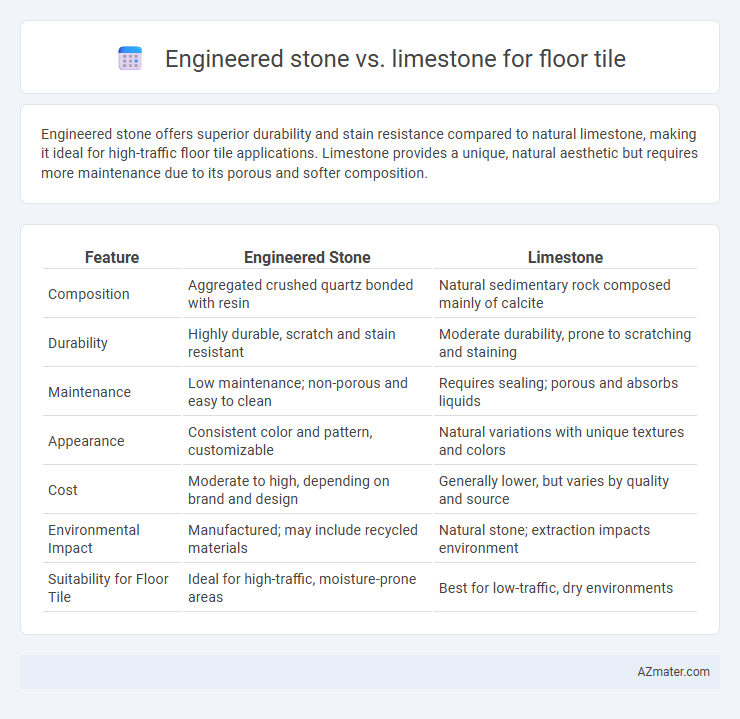Engineered stone offers superior durability and stain resistance compared to natural limestone, making it ideal for high-traffic floor tile applications. Limestone provides a unique, natural aesthetic but requires more maintenance due to its porous and softer composition.
Table of Comparison
| Feature | Engineered Stone | Limestone |
|---|---|---|
| Composition | Aggregated crushed quartz bonded with resin | Natural sedimentary rock composed mainly of calcite |
| Durability | Highly durable, scratch and stain resistant | Moderate durability, prone to scratching and staining |
| Maintenance | Low maintenance; non-porous and easy to clean | Requires sealing; porous and absorbs liquids |
| Appearance | Consistent color and pattern, customizable | Natural variations with unique textures and colors |
| Cost | Moderate to high, depending on brand and design | Generally lower, but varies by quality and source |
| Environmental Impact | Manufactured; may include recycled materials | Natural stone; extraction impacts environment |
| Suitability for Floor Tile | Ideal for high-traffic, moisture-prone areas | Best for low-traffic, dry environments |
Overview of Engineered Stone and Limestone
Engineered stone is a composite material made from crushed natural stone bound together by resin, offering enhanced durability, stain resistance, and uniform aesthetics ideal for high-traffic floor tile applications. Limestone, a natural sedimentary rock composed primarily of calcium carbonate, provides a classic, warm appearance but is softer and more porous, requiring regular sealing to prevent damage and staining. While engineered stone tiles deliver consistent performance and low maintenance, limestone tiles offer unique natural variations and a timeless, elegant look preferred in traditional architectural designs.
Composition and Manufacturing Process
Engineered stone floor tiles are composed mainly of natural quartz crystals bonded with resin and pigments, resulting in a highly durable and non-porous surface. Limestone tiles are natural sedimentary rock primarily made of calcium carbonate, formed through the accumulation of marine organism remains over millions of years. The manufacturing process of engineered stone involves mixing crushed quartz with polymer resins followed by curing under heat and pressure, whereas limestone tiles are simply cut and polished from quarried slabs without any binding agents.
Appearance and Design Variety
Engineered stone floor tiles offer a wide array of colors, patterns, and textures that mimic natural stones like marble and granite, providing consistent and customizable aesthetics for modern interiors. Limestone features unique, naturally occurring veining and subtle earth tones, giving each tile a distinct and timeless organic appearance that complements traditional and rustic designs. The engineered stone's versatility in design variety makes it ideal for bold, contemporary spaces, while limestone's natural charm suits classic, warm environments.
Durability and Hardness
Engineered stone floor tiles exhibit superior durability and hardness compared to limestone, with a Mohs hardness rating typically around 7, making them highly resistant to scratches and wear. Limestone, a softer natural stone with a Mohs hardness of approximately 3 to 4, is more susceptible to chipping, scratching, and acid etching from spills. Engineered stone's composition of crushed quartz and resin enhances longevity and impact resistance, making it ideal for high-traffic areas, whereas limestone requires more maintenance and care to preserve its appearance.
Maintenance and Cleaning Requirements
Engineered stone floor tiles require minimal maintenance due to their non-porous surface, resisting stains and scratches without the need for sealing. Limestone tiles, being porous natural stone, demand regular sealing and gentle cleaning to prevent staining and etching from acidic substances. Routine cleaning with pH-neutral cleaners preserves limestone's appearance, whereas engineered stone benefits from simple wiping with mild soap and water.
Slip Resistance and Safety
Engineered stone floor tiles offer superior slip resistance compared to limestone due to their non-porous surface and embedded anti-slip additives, enhancing safety in wet or high-traffic areas. Limestone's natural texture can vary, often making it more porous and prone to becoming slippery when wet unless treated with sealants, which require regular maintenance. Choosing engineered stone improves long-term safety with consistent slip resistance, while limestone demands ongoing care to maintain a similar level of slip performance.
Environmental Impact and Sustainability
Engineered stone floor tiles typically have a lower environmental impact due to their use of recycled materials and less intensive quarrying compared to natural limestone, which requires significant extraction and processing that can disrupt ecosystems. Limestone floors contribute to habitat degradation and carbon emissions from mining, while engineered stone often incorporates sustainable practices such as reduced waste and energy-efficient manufacturing. The durability and low porosity of engineered stone also extend floor life, minimizing resource consumption over time compared to the more porous and softer limestone tiles.
Cost Comparison
Engineered stone floor tiles typically cost between $50 and $100 per square foot, offering durability and low maintenance compared to natural limestone, which ranges from $30 to $70 per square foot. Limestone requires regular sealing and can be prone to scratches and stains, potentially increasing long-term upkeep expenses. Factoring installation, engineered stone's uniformity and strength often result in lower lifecycle costs despite a higher initial price.
Installation Considerations
Engineered stone offers easier installation due to its uniform thickness and enhanced durability, reducing the risk of breakage during handling and cutting compared to limestone. Limestone, being a natural material, requires specialized tools and experienced installers to manage its softness and variability, which can increase installation time and costs. Proper substrate preparation is essential for both materials, but engineered stone's stability often allows for quicker setting and less post-installation maintenance.
Best Applications for Each Material
Engineered stone floor tiles excel in high-traffic areas and kitchens due to their exceptional durability, stain resistance, and low maintenance requirements. Limestone is best suited for low-traffic residential spaces or bathrooms, offering a natural, warm aesthetic but requiring regular sealing to prevent damage. Choosing between these materials depends on balancing durability needs with desired aesthetic and maintenance levels in the installation environment.

Infographic: Engineered stone vs Limestone for Floor Tile
 azmater.com
azmater.com